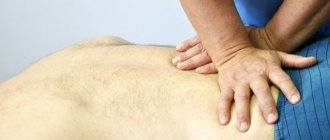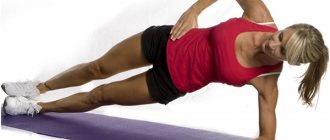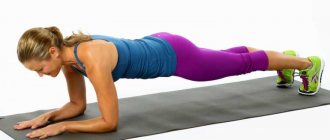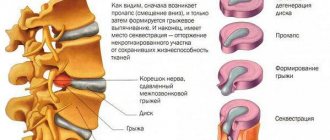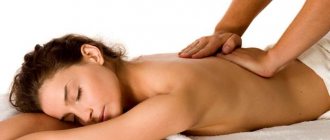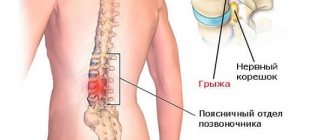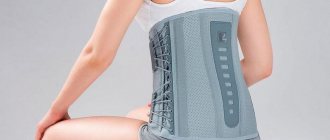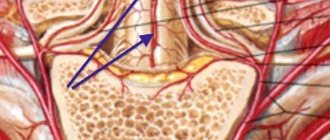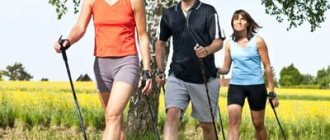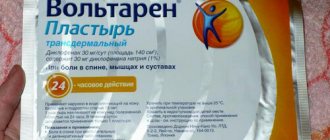Among the numerous conservative methods of treating exacerbations of osteochondrosis, which include protrusions and herniated intervertebral discs, there are not only methods of hardware physiotherapy, but also numerous manual techniques. Perhaps the most famous are manual therapy and massage. How effective is a correctly prescribed, competently performed massage for protrusion of the lumbar spine? When should it be prescribed to a patient? What therapeutic factors of massage can be used to stabilize the condition and reduce the severity of pain? When will it be contraindicated?
Protrusion on MRI.
We should start by explaining why massage is useful for pathologies of the musculoskeletal system in general, and for protrusions in particular. But how does protrusion or extrusion differ from a hernia?
Differences between protrusion and disc herniation
A protrusion is a defect of the intervertebral disc that has developed under excessive pressure, in which the disc itself still remains intact, but its normal contours change. A bulging zone appears that protrudes beyond the vertebral body; it puts pressure on the surrounding soft tissue, which causes complaints and symptoms.
Hernia with stenosis.
If the outer layers of the disc, which consist of strong, circularly arranged fibrous fibers, still cannot withstand the pressure of the central regions of the disc, then they rupture and can no longer restrain further loss of the internal structures of the nucleus pulposus.
Such a protrusion, when the disc has already ruptured and is not a complete formation with a normal contour, is called an intervertebral hernia. One important conclusion follows from this. There is no such situation that first a hernia occurs in the same intervertebral disc, and then a protrusion. It happens exactly the opposite: “where it’s thin, it breaks.”
Protrusion of the disc and pressure on the nerve root.
Most often, a protrusion of the disc, or protrusion, exists for a long time, and then, when exposed to a resolving factor, for example, physical activity, the circular layers of the disc rupture, and a real hernia is formed. Naturally, a disc herniation causes a more vivid clinical picture and severity of symptoms than protrusion. Protrusion is always primary; with skillful treatment, it is possible to prevent its transformation into a hernia, and therefore the operation to remove the hernia. A competent massage provides significant assistance in this. What are the factors influencing therapeutic and preventive massage?
Who will treat you?
In our center, we have assembled an excellent team of doctors who can not only professionally diagnose and formulate a course of treatment, but also carry out all the necessary procedures. You can get to know our doctors and the level of their work better in the video on the website and from the video reviews of our patients below.
Dremin Evgeniy Vitalievich
neurologist, reflexologist, chiropractor.
6 years of experience. more
Learn more about manual therapy
Impact of massage
Massage is not only a simple “muscle kneading”, but a whole complex of activities that activate the neuroendocrine system and normalize muscle tone, both when it weakens and when it increases. Three main therapeutic factors can be distinguished: neuro-reflex, humoral, and mechanical effects. What are these factors? Here is their brief assessment:
- The neuro-reflex factor arises as a result of the rhythmic mechanical influence produced by the hands of a specialist. Various movements, changes in pressure, and tempo lead to periodic activation of large receptor fields of afferent (sensitive) impulses in the brain. The activation of the autonomic nervous system is connected, associated with the need to change blood flow in the area of influence. In the cerebral cortex, at the correct, calm pace of work, a focus of diffuse inhibition is formed, so after the procedure the person is in a state of pleasant relaxation. He wants to sleep or take a nap.
After processing the impulse, they are transformed into motor signals to muscles, blood vessels, soft tissues, and internal organs. The muscles restore impaired tone, the blood volume is redistributed in the vessels, the inflammatory edema associated with the occurrence of protrusion, as well as hernia, is eliminated;
- The humoral factor is associated with the release of special biologically active substances into the blood. These are norepinephrine, acetylcholine, histamine, bradykinin. These substances, being universal, can both help restore the body’s immune status and also have a negative effect under special conditions. Blood flow to the skin after a session, redness, a feeling of warmth - this is certainly a positive effect.
In the case of an acute allergic reaction, an excess of the same histamine causes severe skin itching, hives, and Quincke's edema. This is an example of how one substance can have positive and negative effects on the body;
- mechanical factor. The physical work of a massage therapist on the skin and subcutaneous tissue leads to improved blood circulation in the outer layers of soft tissues, and their resistance to the influence of hands increases. In the case of conduction sensitivity disorders, improved blood circulation sometimes makes it possible to restore tactile and pain sensitivity.
Back after massage.
The skin is cleansed, swelling in the subcutaneous tissue of the lower back is eliminated, and the excess heat provided by the movements and hands of the massage therapist promotes blood flow to the skin, its outflow from the deep muscles of the back, as well as the zone of inflammation that appears under the influence of protrusion and hernia.
Muscles respond with great gratitude to a properly performed massage. Their tone is normalized, blood supply and venous outflow are improved. Lactic acid begins to be released from the deep back muscles, which are irritated by protrusion, hernia and osteophytes. This improves muscle contractility, lymphatic drainage from them, and muscle regeneration increases.
In the case of a long history of the disease and the involvement of muscles in the secondary inflammatory process, proper massage can even lead to the release of muscles from cicatricial adhesions and increase their strength in case of flaccid or peripheral paralysis and paresis. It is these types of movement disorders that occur with protrusions, and even more so with herniated intervertebral discs.
Despite the fact that the intervertebral joints in each individual case are relatively inactive due to their small amplitude, the impact of the hands improves articular circulation and leads to strengthening of the ligamentous apparatus of the spine. Accordingly, the venous outflow from the deep fascia of the back and longitudinal ligaments, which are rich in nerve endings and cause severe pain with discogenic complications of osteochondrosis, improves.
Healthy and osteochondrosis-affected spine on CT scan.
We must not forget about the formation of new conditioned reflex connections that are caused by regularly repeated sessions. For example, a competent specialist can use vibration and tapping techniques in the lumbosacral region to enhance intestinal motility and additionally help the patient in the fight against atonic constipation.
Massage of the lumbosacral area can be of great help in improving blood circulation in the pelvic organs, as well as in the lower extremities. Massage of this area, in addition to eliminating pain from protrusions and hernias, can be indicated for patients with an inactive stage of CNM - varicose veins. It helps women and men with chronic congestion in the pelvis, for example, in the presence of benign prostatic hyperplasia (prostate adenoma).
There are other zones rich in vegetative fibers that can be considered reflexogenic. For example, when massaging the protruding 7th cervical vertebra, the reflex effect on the heart is activated, and the effect on the area of the 5th thoracic vertebra improves blood flow to the stomach.
Diagnostics
The examination and treatment is carried out by a neurologist. In most cases, diagnosis is limited to x-rays, which are often done for another reason, and Schmorl's hernia is discovered by chance. X-rays visualize spinal curvature, osteoporosis, osteochondrosis and spondyloarthrosis.
Intense pain may indicate an intervertebral hernia. But it cannot be detected on x-ray, so the patient is sent for an MRI. If such a procedure is not available for some reason, it is replaced by CT. The doctor may also order blood and urine tests.
Is it possible to massage during protrusion?
If you have read this far, it has become clear that massage for protrusion and hernias is not only possible, but also necessary. However, the goal must be clearly defined. After all, neither massage nor manual therapy can either correct a hernia, much less radically cure the disease. Why is this procedure prescribed?
The purpose of massage for complications of osteochondrosis is a significant improvement in the condition, a sharp reduction or elimination of pain, an increase in the amplitude and strength of movements in the back. Accordingly, the patient’s sleep and overall quality of life improves. How does a massage therapist achieve this improvement? First of all, this is a stretch of the lumbar spine. Special techniques increase the negative pressure between the vertebral body and the intervertebral disc in each segment, this has a positive effect on protrusion. The nucleus pulposus ceases to put pressure on the outer layers of the disc, and the rupture of the fibrous ring, leading to the appearance of a hernia, either occurs much later or does not occur at all. Massage helps prevent weakness and atrophy of the back muscles, including deep ones, they begin to perform their function better. This leads to the fact that in a standing position, healthy muscles take on part of the load and relieve the intervertebral discs. Therefore, proper massage prevents the formation of protrusions and hernias in other segments. What are the indications for discogenic complications of osteochondrosis and contraindications for the procedure?
Manual therapy methods
Manual therapy demonstrates high effectiveness in the treatment of hernias that arise as a result of displacement of the vertebrae or intervertebral discs, deformation and dysfunction of the spinal column. Pressure on localized points and stretching of muscle fibers allows the structures to return to their natural position.
Achieving results is ensured by using several methods of manual therapy:
- Muscle-energy method.
This technique is the mildest in impact, and therefore has a minimum of contraindications. The treatment eliminates sudden shocks, active movement, and is aimed at relaxing muscle fibers and smoothly stretching them to increase elasticity and increase blood circulation. This allows you to gently return the spinal segments to their place. The method is suitable for use in cases of severe pain. - Musculofascial release.
A mild impact most often does not cause any discomfort in the patient. Smooth and slow movements aimed at stretching and stretching muscle fibers gradually restore flexibility to the spinal column. The technique relieves swelling in tissues and relieves pain. Despite the softness of the impact, it has significant power. - Pulse technology.
A more traumatic technique should only be performed by a qualified specialist, as it can aggravate the displacement of the intervertebral disc or lead to pinched nerve fibers. Impulse effects involve sharp jolts, rapid tapping, and high intensity movements. The procedure is aimed at restoring the position of displaced vertebrae along the vertical axis. The force of impact is usually moderate, but the movements are sharp, so the accuracy of the actions performed is important. - Craniosacral osteopathy.
The technique covers all segments of the spinal column. Using techniques of stretching, pressing, twisting and turning, the doctor restores the correct position of the vertebrae along the entire length, correcting postural disorders. During treatment, the clearance between the vertebrae increases and the blood supply to tissues improves.
Indications and contraindications
The most important indication is the absence of an acute condition. Massage, like any type of physiotherapy, is indicated outside the acute stage. As a last resort, massage of the lumbosacral spine and back can be performed starting from the stage of fading exacerbation, or incomplete remission.
In this case, it is necessary to diligently avoid putting pressure on the intervertebral disc that has a herniation or protrusion and is to blame for the development of symptoms. During the remission stage, massage can be performed by lightly influencing the corresponding vertebra.
Contraindications include various concomitant diseases. Among them:
- any oncology, including blood diseases;
- fever, or increased temperature, acute infection;
- high or low blood pressure, heart rhythm disturbances;
- the presence of unstable angina or angina at rest;
- intracranial hypertension;
- recent myocardial infarction;
- severe cachexia, or exhaustion;
- extremely advanced age of the patient, risk of pathological fractures due to osteoporosis;
- mental disorders and diseases such as schizophrenia, severe forms of epilepsy;
- the presence of infectious skin lesions, both bacterial and viral. These are vesicular lichen or herpes, streptoderma, erysipelas, pustular infection, furunculosis;
- chronic cardiac, hepatic, renal failure;
- inflammation of the bone marrow, or osteomyelitis, various forms of tuberculosis;
- hemophilia, and vice versa, thrombotic conditions.
A relative contraindication to massage can be considered a violation of the integrity of the skin at the sites of impact, for example, psoriasis and eczema. In case of remission or minor manifestations of the rash, massage is still possible, but in case of exacerbation it is better to avoid it.
Finally, there are temporary natural conditions in which massage is contraindicated. It should not be done during menstruation or pregnancy.
Types of massage
Most often, ordinary, classic manual therapeutic and prophylactic massage is used. It is carried out according to general rules, starting with superficial and then deep stroking, then such techniques as rubbing, kneading, vibration and effleurage are added. Tapping and vibration should be carried out carefully, outside the area of the protrusion or hernia. The point is to influence not the protrusion and hernia, but the surrounding soft tissue in order to relieve inflammation, reduce swelling, and restore muscle tone along with blood circulation.
Massage begins from the cervical area down the spinal column.
Also, classic massage of the lumbosacral spine and back in general always precedes the procedure of therapeutic traction, or traction therapy. It is extremely useful to combine massage with hydrotherapy, therapeutic baths with mineral water, and water aerobics in the absence of contraindications. Water treatments additionally normalize lymphatic drainage and venous circulation much better than hardware methods. The additional absence of static load on the spine when in water reduces disc pressure, which promotes rapid regression and reduction of pain.
Reviews
Pavlovsky Yu.N.
Recently, a nerve in my spine became pinched and my leg began to fail. We turned to the doctor Vladislav Beskrovny - we knew for a long time that he was an excellent specialist, especially since he trained with his father, a well-known neurosurgeon in the Khabarovsk Territory. I did an MRI, the results were disappointing: a prolapsed hernia in the lumbar region with a sequester that had fallen into the spinal canal, which had to be removed only surgically. But Vladislav Anatolyevich suggested trying a new treatment method: for almost a month I visited the physiotherapy room every day at the Diagnost medical center, where they performed electrophoresis with Karipazim, and once every five days they injected me with my own blood, only, as the doctors explained, it was enriched with platelets. After completing the course, I had a repeat MRI. The results were shocking: the professor could not understand what happened, who treated it and by what method! The hernia has gone 3 mm, and at the moment everything has healed. And the prolapsed sequestrum, which needed to be operated on, completely disappeared, as well as all the protrusions that were previously diagnosed. And the doctor assured: if you manage to build up your muscle corset, then you can “wear bags on your back.” I am very grateful to the doctor for the effective treatment.
Alexander K.
He underwent treatment for a hernia with neuroplasma from Vladislav Anatolyevich Beskrovny. The doctor prescribed a whole range of treatments: electrophoresis with the drug Karipazim, neuroplasma and massage. And it works) The pain went away after the first procedures, and after the entire course, a repeat MRI showed that the hernia itself had decreased. Now I get up in the morning without back pain)
Vacuum massage for hernia and protrusion
During the stage of fading exacerbation, vacuum massage can be used, which creates negative pressure in the soft tissues. However, if the massage therapist uses special medical cups or a device called an aspirator, then he also needs to carefully avoid the localization of the protrusion or hernia. After all, soft tissue has a tendency to follow the can, being drawn into it as it creates negative pressure. A hernial protrusion is no exception, and although it is reliably covered by the vertebral arches and deep muscles, intense vacuum exposure directly at the location of the protrusion and hernia can, on the contrary, intensify the symptoms.
Vacuum massage.
In conclusion, it should be said that, of course, the best option for conducting massage sessions is during a spa treatment. Firstly, the patient is under round-the-clock medical supervision, and the massage is intensified, supplemented by the necessary physiotherapy sessions for the patient, swimming, physical therapy, walks, and spending time in the fresh air. The patient is examined by a doctor, blood pressure is monitored, the necessary diet is prescribed, and concomitant pathologies are treated. This combination of therapeutic factors not only improves the condition of the musculoskeletal system and improves the quality of life, but also has a beneficial effect on the body as a whole.
If the patient independently undergoes courses of therapeutic and preventive massage, then he should expect average prices of 600-800 rubles. in one session of the lumbosacral area for 20 minutes daily or every other day. The course of treatment is 10-14 days. If a general back massage is needed, the price approaches approximately 1000 rubles. per session, depending on the medical center and the qualifications of the specialists.
Prices for manual therapy treatment
| SERVICES LIST | PRICE, RUB. |
| Soft manual techniques (45-60 min.) | 7 500 |
| Osteopathic techniques (30-75 min.) | 7 500 |
| Magnetic Vacuum Acupuncture | 1 600 |
| Intra-articular administration of a drug (excluding the cost of the drug) | 4 400 |
| Intra-articular injection (diprospan) | 5 500 |
| Orthoplasma into the joint | 7 000 |
| Intra-Articular PRP Injection | 6 500 |
| PRP therapy for tendonitis, ligamentitis, contractures | 6 500 |
Contact us
Call now
8 (495) 803-27-45
Make an appointment through our service
Make an appointment
